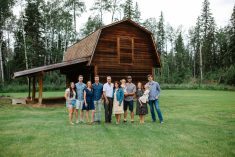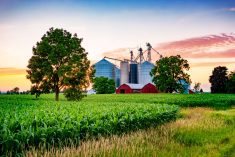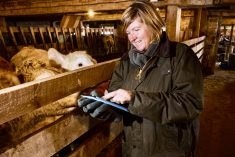It isn’t always easy to get a clear picture of how the pattern of farmland ownership is changing across Canada, particularly in the Prairie provinces. In Alberta, land titles data is expensive to purchase and in Manitoba, the provincial government has to give permission for access, even for research purposes, and that can take several years.
Further exacerbating attempts to get a firm handle on farm consolidation and ownership concentration is the fact that the land base for a farming operation is often owned under a number of different names.
Today’s farm operations frequently have complex structures involving partnerships, joint ventures and corporations, with land owned by several individuals and/or entities.
“A given operation might be farming land titled under several individual and corporate names. In the Land Titles Registry, there is no simple way to connect these parcels to a given farming entity,” says Annette Desmarais, Canada research chair in human rights, social justice and food sovereignty at the University of Manitoba.
Read Also

What to consider when setting up farm-related business ventures
Things to consider before launching a farm-adjacent side business.
Desmarais has been conducting research into changing land tenure patterns on the Canadian Prairies since 2014 with her most intensive work focused on Saskatchewan, where land titles information is publicly available for free. Desmarais’s research team also conducted interviews with 45 farmers, municipal employees and reeves across Manitoba, Saskatchewan and Alberta, and surveyed 400 farmers across the three provinces.
The research confirms there was definite increase in the number of acres purchased by investors in Saskatchewan from 2002 to 2014 and also that land prices in the 15 municipalities where these purchases were concentrated had risen.
“What surprised us was how much more they were paying than other farmers,” Desmarais says. “At the time (2017), investors were saying that their presence had no influence on the market, and we were able to show that they were contributing to increasing prices for land.”
Are farmers concerned about who owns what?
Findings suggest farmers across the region are very concerned about the increasing amount of land being purchased by non-ag investors and mega-farms (larger than 30,000 acres).
Of the 400 farmers surveyed in 2019, 74 per cent believed farmland ownership had become more concentrated in their region over the last 10 years, and of those, 68 per cent believed it had become somewhat of a problem or a major problem.
Among Saskatchewan farmers, the most frequently cited issues associated with land concentration were the ability of large owners to outcompete smaller players for land (61 per cent), the declining number of local farmers (45 per cent), negative impacts on the local community (41 per cent), and less local land for sale (39 per cent).
Most surveyed farmers also believe non-farmer ownership is restricting access to land, especially for younger farmers.
“It’s difficult for them to get started in farming because of the huge investment required,” agrees Sheldon Froese, a real estate broker with Royal LePage Riverbend Realty in Manitoba.
“We’re seeing this in all sectors of any business whether it’s buying rental units or condos. Things have changed but definitely our land prices have made it a little harder for some local people to buy bigger farms.”
But at least in Manitoba and Saskatchewan, Froese doesn’t see large tracts of land being snapped up by people who are not farming it.
“We’ve had the odd people invest in land, but they’ve always rented it back to farmers and that’s one way the young people have been getting into farming — by renting land from people that just want to buy land to invest in it,” he says. “Because they’re on the investment side, it’s not like they will take it away and farm it themselves someday, so people can make a good business plan for the future or at least get started, have a good income and build their own land ownership from there.”
Ontario is seeing similar trends with outside investors buying farmland over the past decade, especially land close to urban developments where prices can reach upwards of $40,000 an acre. The scale of those purchases may not parallel the West, though.
“There’s no question those institutional buyers are present here but they still don’t make up a significant part of the market,” says real estate broker Phil Spoelstra of Remax FarmOntario Team.
“For the kind of return on investment and capital appreciation they want, which is their main driver, the Prairies provided them with more opportunity over the last number of years,” Spoelstra says. “We saw more investment out that way than here where it’s harder with our land prices, to get the two to three per cent annual return on investment that they would like to see.”
That doesn’t mean Ontario farmers aren’t also concerned about outside investors.
“There’s legitimate concern around institutional ownership,” Spoelstra says. “There are some opportunities within institutional land ownership such as farmers building rental land operations but ultimately there is no ownership in those models, and ownership is control. Farmers need to own the land.”
What’s the impact?
Many farmers told Desmarais’s survey team that these trends are hurting local communities. Farmers from other provinces are buying a second farm in Saskatchewan and going back and forth. they said, and outside investors with no ties to the community are contributing to the decline of rural towns.
A similarly large number of farmers told the survey team that farm consolidation and the concentration of land in the hands of larger farms and outside investors had weakened their communities, caused depopulation and eroded local services.
Farmers also identified a concern that non-ag investors will take land out of agricultural production, either deliberately or as a result of poor decision-making.
It’s an especially pressing concern in markets with the tightest supplies. “Land that is bought and sold again and is not in production is troubling for farmers,” says Marianna Westerkamp, owner of Westerkamp Realty on P.E.I. “The land is limited and needs to stay in production.”
The research also highlighted the ecological impact of farm consolidation such as loss of biodiversity and wildlife habitat, either from larger operators clearing shelterbelts, bushland and sloughs to accommodate larger machinery or make the land more attractive to lease, or because the competition for land, and the inability of some smaller operators to purchase more acres to expand drives them to clear marginal land because of economics.
In some cases, land bought by investors is rented back to the farmer it was bought from, or they hire farm managers, but rarely do they farm it themselves.
“Clearly, access to land and what’s happening with land is key, and in the context of all these aging farmers, many of whom don’t have a succession plan, we are setting ourselves up for an unknown future about who owns the farm,” says Desmarais.
“The issue is that the price of land is higher than its productive value so you won’t be able to pay that off in one generation. If you do access land you are signing up future generations to that debt.”
It’s also prompting changes in the structure of family-owned farms that are shifting towards a more formal business model with CEOs and professional management.
Desmarais recently published an article in The Conversation Canada about her research findings that received 31,000 reads online.
“I have had emails from farmers as a result of that article saying there is a lot of resistance to mega-farms and investors in my part of the province,” she says. “If there is no legislation introduced to make sure that there are more farmers on the land, what would stop those who already have a lot of land and capital from continuing to grow, because that is what they are going to do. You need to change policy if you want to have a lot more people living in rural areas. I think farmers should be really involved.”

